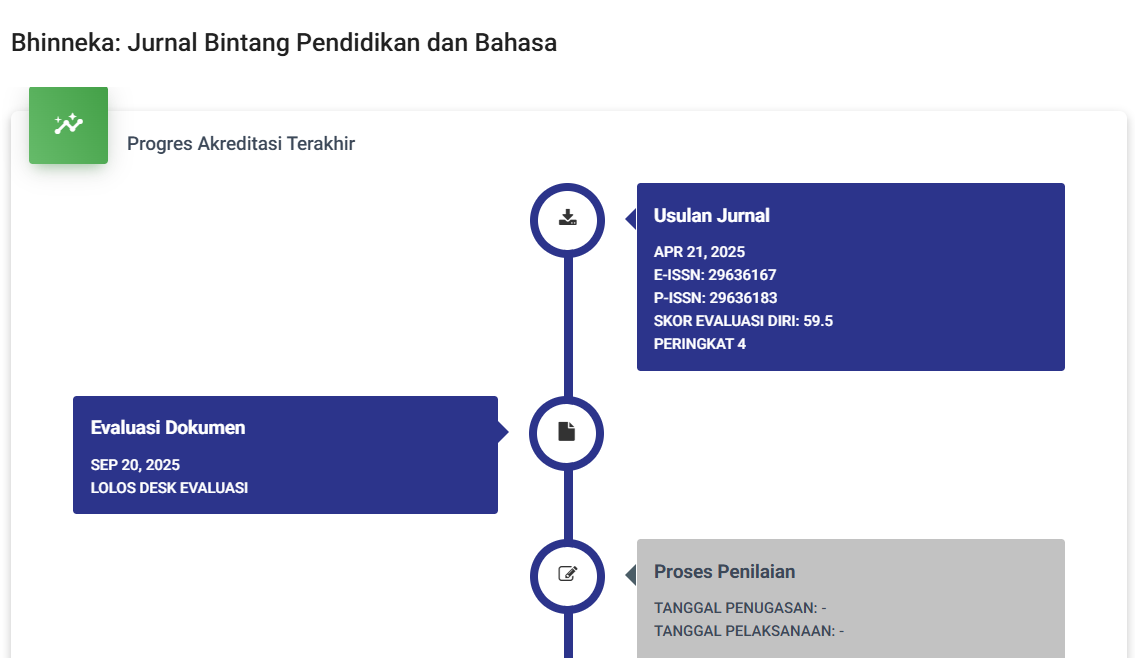Perbedaan Tingkat Self Control pada Mahasiswa Bimbingan dan Konseling Universitas Sanata Dharma Pengguna Media Sosial X (Twitter) ditinjau dari Jenis Kelamin
DOI:
https://doi.org/10.59024/bhinneka.v2i4.1066Keywords:
Self Control, Student X social media users, genderAbstract
This research aims to (1) Knowing the differences in self-control among guidance and counseling students at Sanata Dharma University who use social media X (Twitter) based on gender. (2) Determine the level of self-control among guidance and counseling students at Sanata Dharma University who use social media X (Twitter). (3) Knowing the level of self-control among guidance and counseling students at Sanata Dharma University who use social media X (Twitter). Type of quantitative research with a comparative approach. The subjects in this research were BK USD students who used Twitter, totaling 30 male and 30 female students. The questionnaire is based on Averill's self-control theory (in Ghufron and Risnawati, 2010) which has three aspects including: Behavioral control, cognitive control, and control in making decisions. The validity test results obtained a total of 39 valid items.The research results show differences in the level of self-control between guidance and counseling male students and female students who use social media based on the results of Mann Whitney, asymp. the significant value is 0.000 < 0.05, then the Ha (alternative hypothesis) is accepted and the Ho (null hypothesis) is rejected. Male students have lower self-control than female students. Male students tend to have a moderate level of self-control around 21 (70%) and female students tend to have a high level of self-control around 21 (70%).
References
Alvira Iswinda Mu’alifah & Sumardjijati . (2023). SELF DISCLOSURE PADA PENGGUNA MEDIA SOSIAL TWITTER (Studi Kualitatif Self Disclosure Pada Pengguna Media Sosial Twitter). JURNAL SIGNAL, 11(1), 01. https://doi.org/10.33603/signal.v11i1.7510
Anggraini, W., Dewi, R., & Astuti, W. (2023). Kontrol Diri pada Remaja Pengguna Tik Tok. 1(1).
Baitanu, J. Z., Masihin, L., Rustan, L. D., Siregar, D., & Aiba, S. (2022). Hubungan Antara Usia, Jenis Kelamin, Mobilitas, Dan Pengetahuan Dengan Kejadian Demam Berdarah Dengue Di Wulauan, Kabupaten Minahasa. Malahayati Nursing Journal, 4(5), 1230–1241. https://doi.org/10.33024/mnj.v4i5.6348
Burt, C. H. (n.d.). Pengendalian Diri dan Kejahatan: Di luar Gottfredson & Teori Hirschi.
Burt, C. H. (2019). Self-Control and Crime: Beyond Gottfredson & Hirschi’s Theory.
Hananto, A., & Huda, B. (2023). PEMANFAATAN SOSIAL MEDIA UNTUK MENINGKATKAN PEREKONOMIAN MASYARAKAT DI DESA SUKASARI, PURWASARI. KARAWANG.
Indrawan, L., Kusuma, G. T., Maris, S., Lukas, J. S., & Febriani, I. (2022). PENGARUH PEMBERIAN JENIS TAYANGAN FILM KARTUN (VISUAL DAN AUDIO) DENGAN JENIS KELAMIN TERHADAP MOOD POSITIF. 3(3).
Khairani, A., & Sukmawati, I. (2023). Perbedaan kontrol diri siswa dalam penggunaan smartphone ditinjau dari jenis kelamin. Counseling and Humanities Review, 3(1), 31–38. https://doi.org/10.24036/000739chr2023
Kurnia, S., & Sitasari, N. W. (2020). KONTROL DIRI DAN PERILAKU PHUBBING PADA REMAJA DI JAKARTA. Jurnal Psikologi, 18.
Kurniasih, C., Yanto, P. N. F., & Aji, B. S. (n.d.). PENTINGNYA KOMPETENSI KEPRIBADIAN BAGI GURU BK DALAM MEMBANGUN KARAKTER SISWA.
Naibaho, F., Agustina, V. F., & Wijayani, M. R. (2023). PENGARUH KONTROL DIRI TERHADAP PERILAKU DISINHIBITION ONLINE EFFECT DI KOMUNITAS REMAJA GEREJA SANTO NIKODEMUS CIPUTAT. Jurnal Psikologi.
Oktavianto, E., Timiyatun, E., & Badi’ah, A. (2021). Studi Korelatif: Kontrol Diri Remaja dengan Kecanduan Menggunakan Internet. 16(2).
Oktavilia, E. A., & Marahayu, N. M. (2021). INSTAGRAM SEBAGAI MEDIA EKSPRESI EMOSI UNTUK MENDUKUNG TERCAPAINYA KESEHATAN MENTAL MAHASISWA.
Ono, S. (2020). Uji Validitas dan Reliabilitas Alat Ukur SG Posture Evaluation. Jurnal Keterapian Fisik, 5(1), 55–61. https://doi.org/10.37341/jkf.v5i1.167
Pane, M. S., & Lubis, F. A. (2023). Minat Mahasiswa Jurusan Asuransi Syariah Fakultas Ekonomi dan Bisnis Islam UIN Sumatera Utara Berkarier di Lembaga Asuransi Prudential Syariah Binjai. 4(2).
Pranoto, Y., & Simbolon, M. J. (2021). PERBEDAAN KEMATANGAN EMOSI BERDASARKAN JENIS KELAMIN DI FK UISU ANGKATAN 2017. 20(2).
Prasetyawati, F. Y., Pradana, R. G., & Mukhibun, A. (n.d.). STUDI KOMPARATIF PERBEDAAN OPTIMISME PEMBELAJARAN DARING PADA MAHASISWA BERDASARKAN JENIS KELAMIN.
Rosmalina, A., & Khaerunnisa, T. (2021). Penggunaan Media Sosial dalam Kesehatan Mental Remaja. Prophetic : Professional, Empathy, Islamic Counseling Journal, 4(1), 49. https://doi.org/10.24235/prophetic.v4i1.8755
Subuh, R. D. (2019). PENGGUNAAN MEDIA SOSIAL DI KALANGAN MAHASISWA FAKULTAS ILMU BUDAYA UNIVERSITAS KHAIRUN. 2.
Tamaraya, A., & Ubaedullah, D. (2021). Dampak Penggunaan Twitter Terhadap Pengungkapan Diri Mahasiswa. INTERAKSI PERADABAN: Jurnal Komunikasi dan Penyiaran Islam, 1(1). https://doi.org/10.15408/interaksi.v1i1.20878
Usmadi, U. (2020). PENGUJIAN PERSYARATAN ANALISIS (UJI HOMOGENITAS DAN UJI NORMALITAS). Inovasi Pendidikan, 7(1). https://doi.org/10.31869/ip.v7i1.2281
Downloads
Published
How to Cite
Issue
Section
License
Copyright (c) 2024 Bhinneka: Jurnal Bintang Pendidikan dan Bahasa

This work is licensed under a Creative Commons Attribution-ShareAlike 4.0 International License.








